- About Us
- Our History
-

Overview
Our origins as the first large-scale research facility in the north-eastern United States.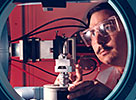
Discoveries
Brookhaven is home to discoveries that led to seven Nobel Prizes.
Unique Facilities
The Lab was conceived to design, construct and operate large scientific research machines.
-
- Awards
- Leadership Team
- Brookhaven Science Associates
- Stakeholder Relations
- External Code of Conduct

Our History of Discovery
Since Brookhaven National Laboratory opened its doors in 1947, countless innovations and inventions by staff and visiting scientists have contributed to research in the fields of physics, chemistry, energy, technology, biology, medicine and more.
Discoveries made at Brookhaven have shaped our understanding of the atom and the universe, advanced medical imaging techniques, and created new technology and tools for studying microbiology, climate and pollution, and energy.
Physics
The Perfect Liquid: Physicists at Brookhaven’s Relativistic Heavy Ion Collider discovered a perfect liquid made entirely of quarks and gluons – a type of matter thought by scientists to have existed microseconds after the Big Bang.
CP Violation: In a discovery that earned them the 1980 Nobel Prize in Physics, James W. Cronin and Val L. Fitch found a flaw in the then-dominant theory of a symmetrical universe where the laws of physics are the same between particles of matter and their mysterious antimatter twins. The discovery of Charge-Parity violation revealed a much more complex cosmos and introduced questions that still puzzle physicists
Parity Violation: In 1957, T. D. Lee, of Columbia University, and C. N. Yang, then of Brookhaven, interpreted results of particle decay experiments at Brookhaven's Cosmotron particle accelerator. They discovered particles which had the same masses, lifetimes and scattering behaviors, but which decayed differently, proving that the fundamental and supposedly absolute law of parity conservation can be violated.
Solar neutrinos: Raymond Davis Jr., a chemist at Brookhaven Lab, won the 2002 Nobel Prize in Physics for detecting solar neutrinos, ghostlike particles produced in the nuclear reactions that power the sun.
Particle discoveries: Brookhaven researchers have uncovered new subatomic particles on many occasions, including the discovery of:
- The muon neutrino,
- The K meson,
- The omega-minus particle,
- The charmed baryon,
- Neutral and negative sigma baryons,
- The phi vector meson,
- The antiparticles Xi-minus and Xi-zero,
- The J/psi particle, whose discovery won Samuel C. C. Ting the 1976 Nobel Prize in Physics
Technology and Energy
MagLev: In 1968, two Brookhaven researchers patented Maglev, the principle of superfast magnetically-levitated transportation. Conceived as a 300-mile-per-hour mass transit alternative to congested highways, Maglev has been actively pursued in Germany and Japan.
Corrosion prevention: Advanced coatings developed at Brookhaven line metal surfaces with an ultrathin film containing nanoparticles – particles measuring billionths of a meter – which makes the metal resistant to corrosion and eliminates the need for toxic chromium.
Multi-grade motor oils: Tests at Brookhaven’s Graphite Research Reactor led to the development of multi-grade motor oils, such as 10W30, which helps engine parts last longer and reduces pollution.
World’s First Video Game: Before there was Atari or Nintendo, there was Tennis for Two, which may have been the first video game ever created, Brookhaven scientists built the pioneering system to entertain visitors to the Lab in 1958.
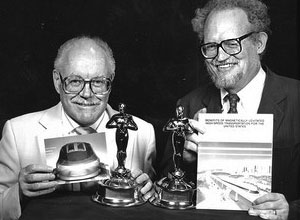
BNL researchers Gordon Danby (left) and James Powell received a patent in 1968 for Maglev.
Medicine and Medical Imaging
Pioneering diagnostic tool: Brookhaven scientists developed technetium-99m, which has become the most widely used radioisotope for imaging diseased organs and is used to diagnose heart disease and other ailments in 11 million Americans each year.
Heart health: Used in hundreds of thousands of heart stress tests each year, thallium-201 is a radioisotope developed at Brookhaven's 60-inch Cyclotron facility. After injection, it concentrates in the heart muscle, allowing doctors to measure damage to the heart.
Human insulin synthesized: The first chemical synthesis of a human protein was that of human insulin done at Brookhaven. This work paved the way for later production of human insulin, which replaced animal insulin in the treatment of diabetes.
DNA sequencing: In 1982, scientists at Brookhaven finished determining the sequence of the DNA of the virus T7, the longest DNA sequence then known. In all, 39,936 base pairs were counted and identified. The genetic map was correlated with T7's protein production, which led to a detailed understanding of how such viruses control their own replication.
Parkinson’s treatment: Developed at Brookhaven in the 1960s, Levodopa or “L-dopa” is still the gold standard for treating Parkinson’s disease.
Lyme disease vaccine: Using Brookhaven’s National Synchrotron Light Source, scientists studied the structure of proteins on Lyme disease-causing bacteria, which then led to a promising vaccine.
Tritiated thymidine: In 1956, Brookhaven researchers discovered a new way to study DNA by attaching the radioisotope tritium to thymidine, one of the building blocks of DNA. Tritiated thymidine also proved useful in studies of cell migration and growth throughout the body. Today, it is used in many different immunological tests and has become a standard for studies in cell proliferation.
Addiction and the brain: From the 1980s into the early 2000s, Brookhaven researchers used PET imaging along with magnetic resonance imaging (MRI) to study how a range of addictive drugs affect the brain and how the brain responds during recovery. These studies showed that addictive drugs localize in the brain’s pleasure center, and that all addictive drugs affect levels of brain dopamine, a neurotransmitter associated with pleasure and reward—helping to establish addiction as a disease. Other studies explored environmental and genetic factors, and potential treatments for addiction. Parallel studies demonstrated that cravings for food can induce similar effects on brain chemistry.
PET scanning: Brookhaven scientists synthesized the first successful radiotracer - called 18FDG - for positron emission tomography (PET) imaging, which is now widely used in neuroscience and cancer imaging.
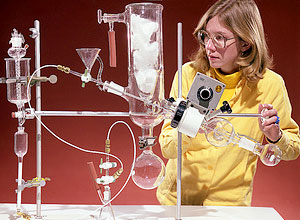
Brookhaven's Joanna Fowler is shown here with an early 18FDG synthesis apparatus in 1979.
Accelerator Technology
Strong-focusing principle: The Courant-Snyder strong focusing principle, conceived at Brookhaven and first employed in the Lab's Alternating Gradient Synchrotron, revolutionized accelerator design and has since become one of the guiding principles behind every new accelerator in the world.
Chasman-Green lattice: Brookhaven researchers developed a novel design for the magnet configuration inside synchrotron radiation storage rings that optimized the brightness of light sources. The design was the basis for Brookhaven’s National Synchrotron Light Source and has since been adopted in the design of new, ever-brighter light sources in the United States, Europe, and Japan.
Electron gun: The laser-photocathode RF gun developed at Brookhaven’s Accelerator Test Facility has become a worldwide standard for high-brightness electron guns.
Magnet design: The Palmer 2-in-1 magnet, which encases two magnets in one block of iron, saves cost and space and provides a more efficient beam for particle accelerators
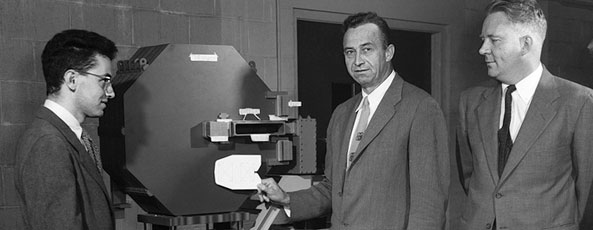
(L to R) Brookhaven physicists Ernst Courant, M. Stanley Livingston, and Hartland Snyder. Livingston holds a cutout showing the relative size difference between an AGS magnet and a Cosmotron magnet, a reduction made possible by the strong focusing principle.
Environment
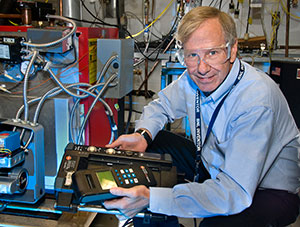
Oil burner research
Clean-burning oil: Since 1980, consumers have saved an estimated $25 billion in fuel costs and avoided 160 megatons of carbon dioxide due to Brookhaven’s breakthroughs in efficient use of distillate oil in boilers, furnaces, direct-fired chillers and integrated power generation equipment.
Pollutant-eating bacteria: Lab research has led to a hazardous-waste treatment technology that significantly reduces the potential for releasing stored waste into the environment. The development of bacteria that eat oil, grease, and toxic waste has yielded applications in purifying crude oil and recovering metals from geothermal mining waste.









